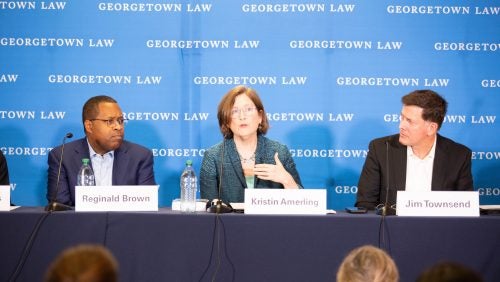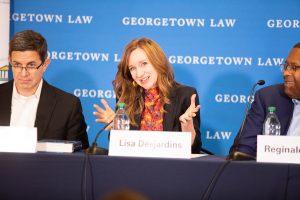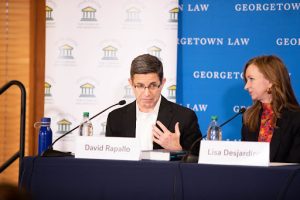The January 6 Committee: Understanding its Innovation and Impact
February 3, 2023

L-R: Panelists Reginald Brown and Kristin Amerling and moderator Jim Townsend of the Levin Center, speaking at the event “How the January 6 Committee Broke the Mold: What it Means for Future Oversight.”
It’s not often that a Congressional oversight committee hearing can draw the same number of TV viewers as a prime-time football game. But last October, some 20 million people tuned into the first public hearing of the House Select Committee to Investigate the January 6th Attack on the United States Capitol.
The subject of the hearings was the big draw – but the committee’s novel structure and its innovations in investigating and presenting evidence also kept Americans riveted. On January 30, Georgetown Law and Wayne State Law School’s Levin Center for Oversight and Democracy brought together committee staff, a witness attorney, and a journalist who covered the hearings for a panel discussion on “How the January 6 Committee Broke the Mold: What it Means for Future Oversight.” The panel was moderated by Levin Center director Jim Townsend.
Victoria Nourse, the Ralph V. Whitworth Professor in Law and director of the Center on Congressional Studies, opened the event by expressing her gratitude for the commitment of the January 6 committee members.
“January 6, hopefully, will never be repeated, but out of January 6th’s ashes came an extraordinary set of hearings,” said Nourse.
MADE FOR THE MASSES
Lisa Desjardins, who covers Congress for the PBS NewsHour, said the committee’s transparency and its efforts to make its hearings media-friendly were both unusual. In addition to a final report of over 800 pages, the committee made an extensive collection – far larger than most Congressional inquiries have in the past – of testimonies, depositions, documents and other items collected during the investigation available to the public in an online database.

PBS NewsHour correspondent Lisa Desjardins
Desjardins said it was a made-for-TV series of hearings because of the clear, compelling presentation of evidence through visuals and witnesses.
“It is like watching a two-hour documentary where you have the same characters as Members of Congress, new witnesses at the beginning of the hearing, a recap of what happened last time and a preview of what will happen tonight,” she said.
A UNIFIED (AND ORGANIZED) FRONT
The panelists agreed that the committee was achieved through bipartisanship and cohesive goals.
Kristin Amerling, Deputy Staff Director and Chief Counsel of the January 6 Committee, said the success of this committee depended on the members’ willingness to put political differences aside and take a collaborative approach.
“Democracy takes work, and this committee was willing to do that work,” she said.
Professor David Rapallo, LL.M’97, LL.M.’99, director of the Federal Legislation Clinic and former congressional investigator, explained that typically, oversight committee hearings operate under a five minute rule, giving each member time to question each witness, which usually results in an extended and disjointed questioning period.

Professor David Rapallo, Associate Professor of Law at Georgetown University Law Center and former congressional investigator
The January 6 committee members stuck to one theme per hearing, and chose one committee member to serve as “captain” for each topic, so each witness interview stayed focused.
Rapallo said selecting committee members committed to investigating the truth had been difficult. House Speaker Kevin McCarthy, then House Minority Leader, initially supported, then rejected a plan to have the committee’s membership evenly split between Democratic and Republican members. In order to ensure the committee would both be bipartisan and would cooperate on its investigation, Rep. Nancy Pelosi, then House Speaker, appointed two Republicans, Rep. Liz Cheney of Wyoming and Rep. Adam Kinzinger of Illinois, both of whom had expressed their willingness to put the interests of the country over partisan political divides.
Amerling added, “Across the political spectrum of the committee, the members were focused on their shared goal of getting the facts right, and that collaborative spirit enabled them to present their narrative and facts and have dialogue with the American public about their findings in a unified way.”
Reginald Brown, a partner at Kirkland & Ellis LLP, who represented witnesses before the committee, agreed that the committee’s approach to storytelling had been extremely effective, but had concerns about the unusual way the committee’s membership was composed.
“[The committee] was bipartisan in composition… but it was organized under rules that did not give the minority party the full discretion that it normally enjoys to pick its own members. And I think that’ll have some interesting long-term implications,” said Brown. “As a defense lawyer, I approach this thinking not only about the work of the January 6th committee, but about DOJ inquiries, bar inquiries, the court of public opinion and the like.”
Rapallo, a veteran of Congressional investigations, agreed that it was possible that, now that control of the House of Representatives had changed parties, the new Republican committee chairs might adopt a “tit for tat” approach to investigating the Biden administration, but that he hoped that would not happen.
“Will they emulate… putting personal or parochial or political interest to the side, and work together and do the really hard work that it takes to come to compromise and agreement?” asked Rapallo. “As these new chairs are just now embarking on their chairmanships, this is something that they might do well to consider.”
Watch the entire event: